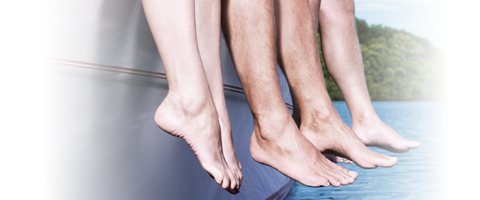Varicose veins are a common disease
Here you will find answers to your questions on varicose veins

Frequently asked questions
What are the different types of varicose veins?
Varicose veins of the legs are divided into spider veins and reticular varicose veins, as well as varicose veins of the perforating, side branch, and trunk veins.
Spider veins are the smallest type of varicose veins. They lie in the skin, measure up to 1 mm in diameter, and can be seen as bluish or reddish-purple veins shimmering through the skin, especially on the sides of the thigh.
Reticular varicose veins lie deeper in the skin and are slightly larger than spider veins, having a diameter of 1-3 mm.
The superficial and deep veins are linked in certain places by blood vessels called perforating veins. These veins can also be affected by varicose disease.
Each leg has two trunk veins, the great and the small saphenous veins (formerly also known as the long and the short saphenous veins). The great saphenous vein runs up the inside of the leg from the medial malleolus of the ankle to the groin, where it empties into the deep vein system. The small saphenous vein runs up the back of the calf from the outside of the ankle to the hollow of the knee, where it also empties into the deep vein system. If the valves in these trunk veins no longer close tightly, varicose veins also develop. Trunk varicose veins usually require treatment.
The trunk veins have numerous large tributaries, known as side branch veins, which interlink with each other. Enlargement of these veins results in side branch varicose veins. They tend to have a very tortuous, snake-like appearance and are often clearly visible as bulges under the skin.
